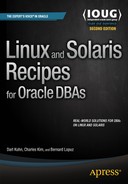Introduction
Successful organizations use data to gain insights about their businesses to make better decisions and discover new growth opportunities. Gathering and storing data and extracting business intelligence is critical for success in today’s competitive environment. Database software and server technologies are used in combination to use vital information assets.
The databases that house this important business data require a stable and effective operating system environment. The Linux and Solaris operating systems excel as cost-effective platforms for database servers. As a DBA, you will inevitably shoulder the responsibility of implementing and maintaining databases running on these systems. Your job depends on your ability to work seamlessly with the server hosting your databases. The more you understand the operating system and tools, the better you’ll be able to perform. The best DBAs are the ones who know how to use which operating system features and in what situations.
This book provides you with task-oriented, ready-made solutions for DBAs in a Linux or Solaris environment. We cover topics from a DBA’s perspective of the operating system. You don’t have to read the book cover to cover; instead, each recipe is a how-to guide for a particular problem. This book allows you to focus on a topic and its corresponding solution.
Audience
This book is for DBAs who work in Linux or Solaris environments. It focuses on command-line tools and techniques for working with the operating system from a DBA’s point of view. If you’re a DBA who wants to operate expertly with Linux technology, this book is for you. Whether you are new or experienced, we provide solutions to tasks that DBAs perform on Linux servers.
How this Book Is Structured
The first few chapters are introductory topics for DBAs working in Linux and Solaris environments. These first chapters provide the foundation for the more complex topics covered in the rest of the chapters in the book.
Subsequent chapters cover advanced technical topics, building on the foundation material and allowing you to expertly leverage the Linux operating system. Each recipe title acts as a pointer to the problem at hand. Within each recipe is a to-the-point solution and a detailed explanation of how it works.
Conventions
The following typographical conventions are used in this book:
- $ is used to denote commands that can be run by the owner of the Oracle binaries (usually named oracle).
- # is used to denote commands that should be run as the root user.
- Italics are used to highlight a new concept or word.
- Monospaced font is used for inline code examples, utility names, file names, and directory paths.
- Constant width bold is used to highlight the statements being discussed.
- UPPERCASE indicates view names, column names, and column values.
- < > are used where you need to provide input, such as a file name or password.
Source Code
The code for the examples shown in this book is available on the Apress web site, www.apress.com. A link can be found on the book’s information page under the Source Code/Downloads tab, which is located underneath the "Related Titles" section of the page.
Errata
Apress makes every effort to make sure that there are no errors in the text or the code. However, to err is human, and as such we recognize the need to keep you informed of any mistakes as they’re discovered and corrected. Errata sheets are available for all our books at www.apress.com. If you find an error that hasn’t already been reported, please let us know. The Apress web site acts as a focus for other information and support, including the code from all Apress books, sample chapters, previews of forthcoming titles, and articles on related topics.
Contacting the Authors
You can contact the authors directly at the following email addresses:
- Darl Kuhn: [email protected]
- Charles Kim: [email protected]
- Bernard Lopuz: [email protected]
